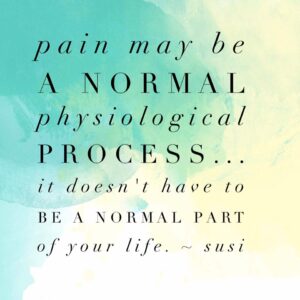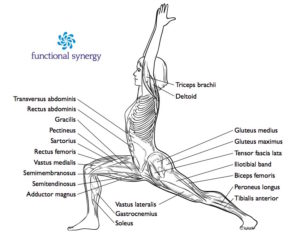By Susi Hately, B.Sc. Kinesiology, C-IAYT Yoga Therapist
Okay, I will admit it. I was one of the masses who bounced in front of my TV in the early 80s to Jane Fonda’s original workout. A short stint of cardio, quite a bit of “feeling the burn,” and an odd desire to wear leg warmers while “working out.”
It brings a smile, doesn’t it?
Now you may be wondering – what the heck does this have to do with yoga, or with anything really, or even with the year 2017 (can you believe it has been that long since Jane’s inaugural video)?
Jane was the leader of many who motivated people to be their best with expressions such as “make it burn,” “no pain, no gain,” “come on, a little higher,” and “you can do more.” As time went on, those lines became part of our thought consciousness.
Enter the 90s, when people started to look for something a little gentler, whole body and mind, more fluid with a little less pounding and pushing. Yoga became mainstream, but the thought patterns remained the same.
Which is why I have been telling people, of a certain age, “to let Jane go”. To let go of the effort, to not try so hard. It doesn’t matter which pose they are practicing, what CrossFit WOD they are doing, or if they are Spinning, Pilates-ing, Running…whatever.
When you “let go of Jane” something happens – physically, neurologically and psychologically:
1. Physically, breathing is better, your body relaxes, as does your soft tissue. When shortened muscles relax, there is greater strength.
2. Neurologically, your system settles. As well, the heart rate slows down, blood pressure lowers and there is a greater level of awareness. Basically, you “feel more”, your introspective awareness increases, and often, you end up going further into the yoga pose – with greater ease. You end up running, lifting, pushing and pulling with much less effort. All of this “going further and doing more” often happens quite quickly, and it feels good. There is much less force, less grip and much more inherent strength and stability. And it feels way better.
3. Psychologically, there is less attachment, and a greater acceptance with what is real and what the body is accomplishing in this moment.
“Letting go of Jane” also applies if you want to step out of pain. Whether you have a chronic rotator cuff issue, sacro-iliac joint pain, back or neck pain; or a psoas muscle that just . . . won’t . . .release, the act of not pushing so hard will also work for you.
Why? If you are in pain and you want to get out of pain, yet you push your way whatever activity you are doing, the following happens:
1. Your muscles and connective tissue resist.
2. You end up compensating elsewhere leading to more tension and more stubborn holding patterns in your body.
3. There is a tendency to hold the breath, and a tendency to use the breath to stabilize rather than your deep core muscles.
4. You won’t relax as easily and whatever strength you build will be built on top of tension which creates an inherently unstable foundation.
5. Your chance for re-injury increases.
Applying “letting go of Jane” in your practice, or if you are a teacher, with your students looks like this:
1. Relax into your movement. If you think about relaxing as a segue to movement, you will be much more likely to “let go.” As you continue to move with relaxation, your strength will improve. Remember, tight muscles are weak muscles, so as tight muscles relax, they will become stronger.
2. Breathe easily. Notice if there is any tension, bracing or “heldness” when you are breathing. If there is tension, back off in order to find the ease. Remember, you want to use your breath to breathe, not to stabilize.
3. If you feel strain or ache, ease out to a position of no strain-free or ache-free. Feel for the non-pain sensations to emerge. (If you have pain or strain constantly through your day, then be sure that your pain symptoms don’t increase with your practice or workout).
4. Don’t believe that your “bad back” or “bad knee” will be “bad” forever. I have seen so many people increase their range of motion, strength, and stability while at the same time reduce or eliminate their aches, strains, or pain.
5. Remember, relaxing is not doing nothing. As Indira Gandhi said, “You must learn to be still in the midst of activity and to be vibrantly alive in repose”. It may be helpful to consider relaxation in movement as relaxed resilience. You will cultivate greater strength.
6. Instead of saying to yourself, “Ooooh, a little further,” say, “Relax just a little more.”
Now there is one “downside” to this kind of practice – especially for the type-A personalities, the driven and motivated individuals in the crowd. The downside is that you will “feel”. This way of practicing may be interpreted as a waste of time, particularly if you have a sun salutation to get through, a headstand to accomplish, or a certain weight lift or time to beat.
This can be a tough pill to swallow. A teacher or a coach can guide you to feel certain parts of your body, and, if you are willful about it, you will hang on and the gains you are seeking will elude you. You’ll build tension, you’ll gain tightness and you’ll wonder why after all this yoga practice your hamstrings are still so darn tight, or after all the working out you are not making many strength gains, or your running speed is still the same.
However, if you can come to the edge of being aware and take a chance at relaxing while you are moving – even for just 2 minutes – you will experience something amazing.
Imagine just how much easier and suppler you could fee. How much faster you could run – with less strain. How much more weight you could lift. Often it isn’t about doing more . . .
Enjoy,
Susi


